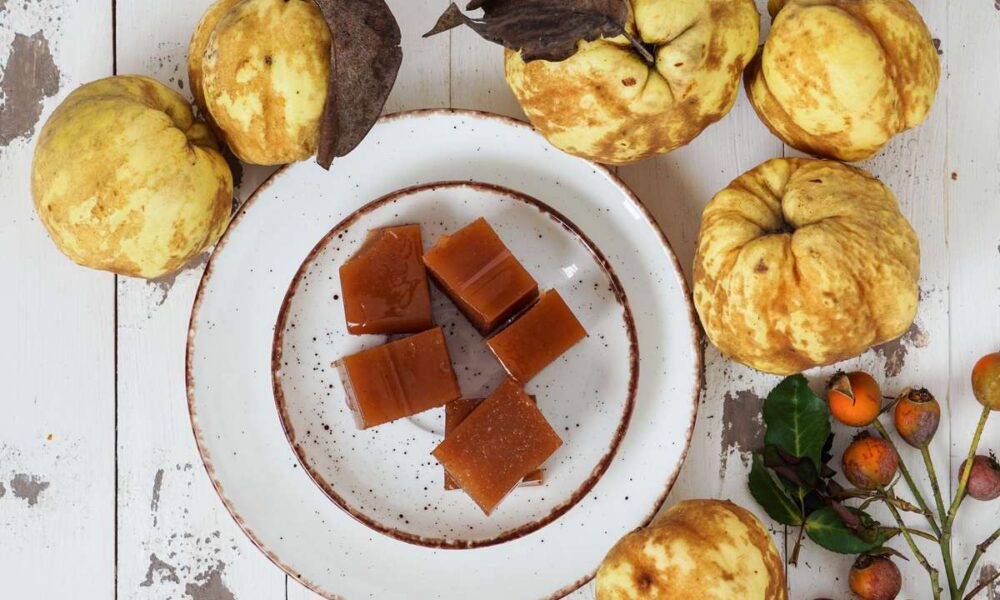Recipes
Quince jelly, the recipe

A preparation with an ancient flavour, hard quince jelly is excellent for a snack and will bring back pleasant memories to your mind.
Hard quince jelly is a recipe that only some will have had the pleasure of tasting. A sort of quince jam which once cooked took on a hard consistency , similar to that of jelly sweets. It was then served cut into pieces and wrapped in greaseproof paper .
Back then, quinces were rather easy to find: many families had a plant in their garden and preparing quince in pieces was just one of the ways to use them. Over time this variety of hard and lumpy-looking apple has been disappearing. However, if you happen to find it in autumn , here's how to prepare quince jelly with the original recipe.
How to prepare the quince jelly recipe
- To prepare the quince jelly, start by washing the apples well and rubbing the peel to remove the fuzz.
- Cut them into pieces and transfer them to a large enough pan together with the lemon juice. Add the water and cook for 30 minutes , stirring occasionally.
- Pass the pulp through a food mill to remove the hardest parts, then put it back on the heat together with the sugar .
- Cook for another 30 minutes then check the cooking: take a spoonful and check that it does not fall.
- Cover square or rectangular ice molds with cling film (if you have silicone ones it will be sufficient to oil them) and pour in the mixture, leveling it well.
- Let the quince jelly cool for a whole day before consuming it. If you like, you can dip it in sugar before serving.
Here is a video with all the steps to make it. As you can see there is nothing complicated: you just need a little patience for cooking.
As well as as a dessert , quince jelly is excellent to accompany mature sheep's or cow's cheeses , perhaps together with croutons.
How to prepare quince jelly with the Thermomix
- Wash the apples, core them and cut them into chunks. Transfer them with the peel into the Thermomix jug together with the lemon juice and water. 40 min. 100°C speed 1.
- At the end, blend at speed 7 for a few seconds, then continue cooking for 15 minutes. Varoma Speed 2 .
- Pour into well-oiled silicone molds and leave to cool for a whole day before consuming.
Variants
Today there are several recipes for quince jelly. The most famous are the Sicilian quince jelly (it seems that the dessert was born in Syracuse) and the Lecce one.
In Sicilian quince jelly the pulp is cooked separately with cores and peel. Only once a puree has been obtained from the first one are they combined by adding the sugar and continuing with cooking in the traditional way. In the Leccese quince jelly, however, the sugar is caramelized separately with a little water and then combined with the cooked apples. In both cases the mixture is placed in decorated single-portion molds and left to harden.
In the Emilian Apennines there is also the custom of brushing the surface with grappa. Another very popular variant is quince jelly spiced with cloves, cinnamon and pepper.
Conservation
Quince jelly can be kept for several months as long as it is kept dry . You can wrap it individually in cling film, put it in glass jars or, as grandmothers did, in tin boxes with two dried bay leaves.
Origin and history
Quinces are often considered a hybrid between the apple tree and the pear tree. In reality, although they belong to the same family, that of the rosaceae , they are a different species. The cultivation of this fruit tree originates in the mists of time: quince trees were found in Greece and Mesopotamia . However, the great obstacle to the consumption of these fruits has always been the sour taste. Just think that they were originally used to perfume wardrobes!
It's difficult to say who had the idea of cooking these fruits with sugar. What is certain is that thanks to the presence of large quantities of pectin in their peel, obtaining this sort of candy was really simple.
Riproduzione riservata © - WT